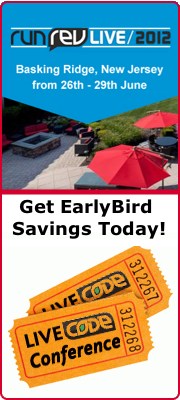
| Issueu 119 | September 29th 2011 | Contact the Editor | How to Contribute |

| ||
|
Engage Audiences with Gamification
What I thought was particularly interesting though, was the many innovative ways in which educators are looking to bridge this gap. A number of progressive teaching professionals demonstrated how they had integrated technology into their teaching practices. And some of the most innovative are looking at ways to refashion their content to take advantage of the full range of complete range of interactive capabilities of today's technology. They see this as an opportunity, a way to make all the smartphones in the room into teaching allies, ones that help to engage students and thus get better learning outcomes. As we move into an increasingly electronic age I think that it is critical that the mainstream in education catches up and delivers content in a form that reflects the experiences students have outside the classroom, in the rest of their lives. Correctly done, interactive content can transform the teaching and learning process. And the process of creating this interactive content - adding interactive, game or social elements - or gamification - is of course well established in industry. It is increasingly being used to engage audiences by adding game elements to business apps and websites. In industry we are seeing a wave of companies introducing gamified elements into their business content. The goal is to engage audiences and get users sharing their experiences so that users stay more engaged for longer. It is something that is happening at every level, from small companies through to the giants. For example, the theme of SAP's recent InnoJam conference was "Gamification for Enterprises". They looked at ways to bring in new and exciting interactive elements to developing with SAP software. The results were amazing, with delegates reporting much more energy, creativity and excitement as a result. Microsoft, NBC/Universal, MTV and many others have been leveraging gamification to take user engagement to the next level. And for smaller organizations, innovative, groundbreaking experiences are the perfect way to make your product or service stand out from the crowd. Educators who want to introduce these elements are occasionally viewed with suspicion in the slower moving education sector. But the tide is gradually turning, and the biggest challenge now revolves more around very limited educational budgets. One approach to solving that is that teachers increasingly are turning to tools that enable them to create interactive content in their own lessons, themselves. This has another advantage beyond simply saving budget: it allows teachers to create lessons that are their own and truly reflect the content and methods they teach. Whether you're an educator or a business, if you haven't thought about it already, I encourage you to consider ways you can incorporate more interactive elements in your own applications or within content, to engage users. There are a few questions you might want to ask yourself before you get started. What benefits could I achieve from increasing the level of engagement of my users with my product or service? Or if you're an educator, how can I make students spend more time thinking about and interacting with my course materials? How might I be able to add interactive elements to the content I already have? How does adding these elements benefit the user? You need to think very carefully about your target audience, the right level of challenge, and consider too if there are ways to get users to collaborate. Spend some time thinking about it to ensure that the features you are add add truly enhance add to your user experience. Remember as you think about the design that these sorts of features are useful not just in engaging your existing users, but they can represent another incredibly useful way of getting them to help spread the word. One example is incorporating elements that encourage users to update their Facebook status at just the right moment, i.e. as they engage with your app. Game makers in particular spend a lot of time working on how to integrate these elements perfectly, sometimes opening up extra levels or providing bonuses for those that use these social features. But there is no reason these features need only be found in games. I know many of you will welcome Facebook's recent announcement of Open Graph as something that will be helpful in getting this experience right. Instead of just being able to "Like" something, you'll soon be able to "Read", "Buy" and even "Play". There are many other ways to incorporate social elements and I encourage you to think about this carefully as you design new applications or updates. When you get these elements right they can make a tangible difference in promoting your application or service, as users connect with others in their social network of friends and colleagues. LiveCode allows you to mix traditional application interface elements such as buttons, text boxes and scrolling data grids with rich graphics, animation and dynamic interactivity. It is easy to incorporate all sorts of social media too. There aren't very many development tools that make it as easy to do this as LiveCode does, and on top of that, the accessible and friendly visual development environment and English-like language puts the creation of this sort of content in range of non-programming educators and those smaller businesses with more limited budgets. Good luck incorporating gamification in your applications. And look out for more from us on this subject soon.
| 
 Tweet
Tweet
|